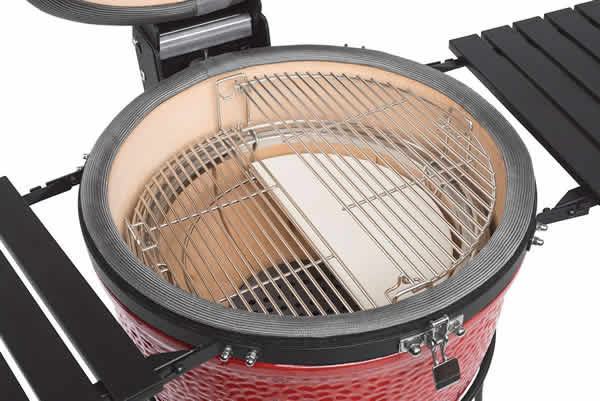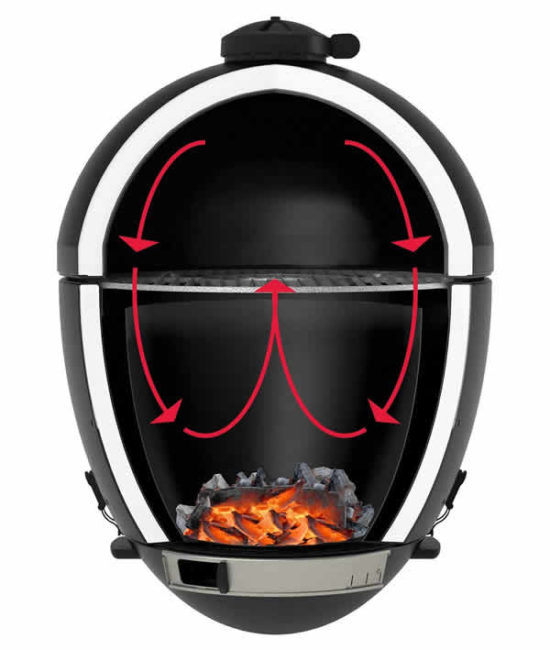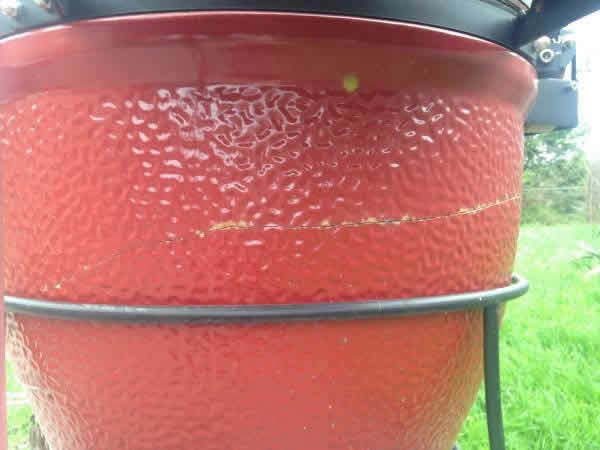The 3 Main Differences Between Steel and Ceramic Kamado Grills
The not-so-age-old question: steel kamado vs. ceramic. Kamado grills of the ceramic variety have been around for a long, long time in one form or another, but steel kamados are a relatively new invention.
Both types of kamado grill are great for outdoor cooking, especially if you’re doing a low-and-slow cook, but which one should you buy? Let’s look at the three main differences between steel and ceramic kamados.
Steel vs. ceramic properties
The most obvious difference is in the material that each grill is made of.
Ceramic kamado grills are really, really heavy. Ceramic is great at retaining heat, and the thicker the ceramic, the better the grill will hold its temperature.
To give you an idea of how big and heavy a ceramic kamado grill can be, the extremely popular KamadoJoe Classic II (Amazon link) has a 256 sq. in. primary cooking area and weighs in at 250 lbs. It literally weighs as much as a full-grown man, and a pretty stout one at that.

Meanwhile, the Char-Griller Akorn Kamado Kooker (Amazon link), something of a legend in its own right, has a 314 sq. in. primary cooking area. In terms of weight, however, the Akorn tips the scales at just 90 lbs. That’s still pretty heavy if you’re assembling it by yourself, but it’s certainly more manageable than the KamadoJoe.
Despite the weight difference, both grills are designed to do the exact same job. They just do it differently. The KamadoJoe retains heat inside a thick layer of ceramic. The much lighter Char-Griller Akorn retains heat inside a triple-walled steel chamber.
Most kamado purists will insist that the ceramic KamadoJoe retains heat better than its steel counterpart, and they’re right. But the difference isn’t dramatic.
There are KamadoJoe owners who report cooking for 18+ hours without having to add charcoal. Akorn owners, near as I can tell, are reporting uninterrupted cooks of up to 16 hours. If that extra 2+ hours of cook time is really important to you, then maybe ceramic is right for you.

Durability
When it comes down to ceramic vs. steel kamado grills, conventional wisdom might lead you to believe that steel will outlast ceramic. Well, it can, but maybe not in the way you think.
If you’ve ever dropped a ceramic coffee cup, you know that ceramic is a pretty fragile material. What happens if you drop or knock over your ceramic kamado grill? Well, it probably won’t shatter like your coffee cup, but there’s a good chance that it’ll crack.
If that happens, you can probably still use it if the crack is small enough. But if it breaks all the way through, you’ll probably need to buy a new grill.

On the bright side, a well-taken-care-of ceramic kamado grill can literally last forever! Seriously. Pass it down to your grandkids.
Steel kamado grills, on the other hand, will need to be replaced at some point. But that’s not unique to steel kamados … ALL steel grills, regardless of shape or size or price, are susceptible to the elements.
Of course, how long it lasts you will depend on how well you take care of it, but there will come a time when you’ll decide to drop it off at the nearest scrap yard.
Price
If you’ve been leaning toward buying a ceramic kamado so far, this is where you might suddenly have a change of heart.
As we’ve already established, ceramic kamado grills can last FOREVER. Very few grills can make that claim. But such durability comes with a pretty steep price, at least when compared to steel kamado grills.
Prices on Amazon change all the time, so I can’t really quote numbers here. Instead, I’m going to give you a handy little comparison chart down below, and Amazon prices should be displayed. Suffice it to say that ceramic kamado grills are a LOT more expensive than the steel variety.
For our purposes here, we’re going to continue to compare the KamadoJoe Classic II with the Char-Griller Akorn Kooker. There are lots of options out there for both ceramic and steel kamados (see more kamados here), but these two grills are fairly representative of full-size kamado grills of each type.
| KamadoJoe Classic II | Char-Griller Akorn Kooker | |
|---|---|---|
| Current Price | ||
| Build Material | Ceramic | Triple-Walled Steel |
| Amazon Expert Assembly | FREE | Available for a fee |
| Primary Cooking Area (sq. in.) | 256 | 314 |
| Heat Range | 225°F – 750°F | 200°F – 700°F |
| Item Dimensions | 26.4 x 26.4 x 36 in | 26.6 x 24.8 x 21.65 in |
| Item Weight | 250 lbs. | 90 lbs. |
| * Primary cooking area measurements do not include warming racks or other add-ons where food might be placed above the main grill grate. | ||
Conclusion
So which one is right for you, ceramic or steel? Only you can make that decision, but here’s what I suggest:
A ceramic grill is a pretty big investment, relatively speaking. It might be a better purchase in the long-term, but I think something like the KamadoJoe is probably best for experienced and/or rabid low-and-slow BBQ enthusiasts. But if money isn’t an issue and you just WANT it, don’t let me stop you! 🙂
On the other hand, if you like the idea of doing long cooks but have little to no experience actually doing it, a steel kamado like the Char-Griller Akorn Kooker is a great way to get started.
Plenty of Akorn owners are thrilled with their purchase. It retains heat much like a ceramic kamado grill, and you should get years of enjoyment out of it if you care for it properly. You’ll get your steel kamado grill at a fraction of the cost of ceramic, and you can always step up to ceramic if you just go bonkers for BBQ!
Regardless of which type of kamado grill you choose, you’re in for some good cookin’.
To learn more about kamado grills, check out Part I of my big ol’ Grill Guide. Or go straight to Part II of the Grill Guide to take a closer look at different kamado grill models.
